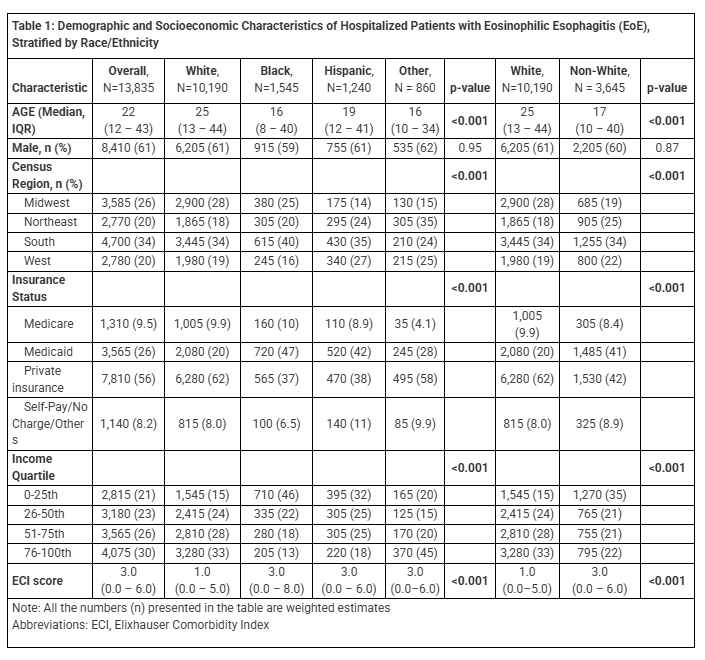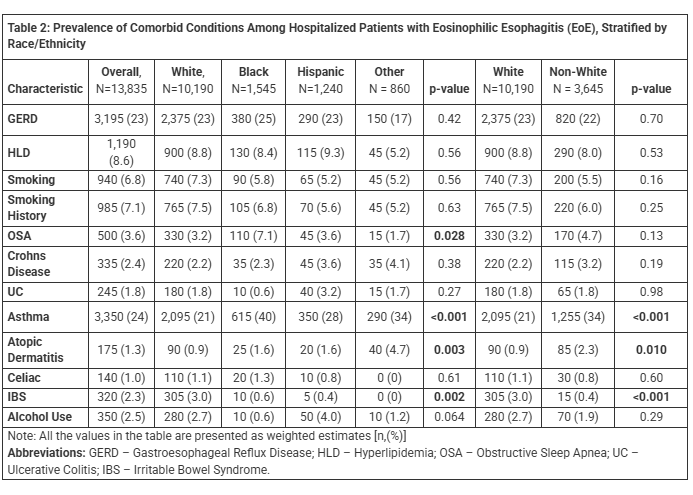Sunday Poster Session
Category: Esophagus
P0667 - Racial Differences in Demographics and Comorbidities Among Patients With Eosinophilic Esophagitis in the United States
Sunday, October 26, 2025
3:30 PM - 7:00 PM PDT
Location: Exhibit Hall

Ritik Goyal, MBBS
Rutgers New Jersey Medical School
Newark, NJ
Presenting Author(s)
Ritik M. Goyal, MBBS1, Bhavik Bansal, MBBS2, Sameer Rao, MBBS1, Eishvauk Aggarwal, MBBS3, Narinderjeet Kaur, MD, MS4, Imran Qureshi, MD1, Menna-Allah Elaskandrany, DO5, Ahmed Al-Khazraji, MD1
1Rutgers New Jersey Medical School, Newark, NJ; 2University of Texas Southwestern Medical Center, Dallas, TX; 3All India Institute of Medical Sciences, New Delhi, Delhi, India; 4SUNY Downstate Health Sciences University, Brooklyn, NY; 5Lenox Hill Hospital, Northwell Health, New York, NY
Introduction: Eosinophilic esophagitis (EoE) is a chronic, allergen-driven, type 2 immune-mediated esophageal disease with rising incidence, particularly in Western countries. It presents with feeding issues and abdominal pain in children, and dysphagia or food impaction in adults. Diagnosis requires ≥15 eosinophils per high-power field on biopsy, after ruling out other causes, especially GERD. EoE is closely linked to atopic conditions such as asthma, allergic rhinitis, and eczema. This study aims to evaluate racial differences in demographics and comorbidities associated with EoE.
Methods: We conducted a retrospective analysis using data from the National Inpatient Sample (NIS) 2016-2022. Patients with a diagnosis of EoE were identified using ICD-10 codes. Demographic variables, insurance status, income quartile, and associated comorbidities were extracted. Weighted estimates were used to represent national hospitalization trends. Comparative analyses between White and non-White patients were performed using appropriate statistical tests, with a significance threshold set at p< 0.05.
Results: A total of 2,767 patients were identified, representing 13,835 weighted hospitalizations. Of these, 10,190 (73.6%) were White, 1,545 (11.2%) Black, 1,240 (9.0%) Hispanic, and 860 (6.2%) other races. White patients had a significantly higher mean age compared to non-White patients (25 vs. 17 years, p< 0.001). Private insurance coverage was more common among Whites (62% vs. 42%, p< 0.001), whereas non-Whites were more likely to have Medicaid (41% vs. 20%, p< 0.001). A greater proportion of non-Whites belonged to the lowest income quartile (35% vs. 15%, p< 0.001), while Whites were more frequently in the highest income quartile (33% vs. 22%, p< 0.001). Among associated conditions, asthma (34% vs. 21%, p< 0.001) and atopic dermatitis (2.3% vs. 0.9%, p< 0.001) were more prevalent in non-Whites. In contrast, irritable bowel syndrome (IBS) was more frequently observed in White patients (3.0% vs. 0.4%, p< 0.001).
Discussion: Our findings reveal significant racial and socioeconomic disparities, with non-White patients more likely to be covered by Medicaid, belong to lower income quartiles, and exhibit higher rates of asthma and atopic dermatitis, suggesting potential racial predispositions. Conversely, the higher prevalence of IBS among White patients may reflect underlying genetic associations. These results underscore the need for targeted interventions based on race for patients with EoE.

Figure: Table 1: Demographic and Socioeconomic Characteristics of Hospitalized Patients with Eosinophilic Esophagitis (EoE), Stratified by Race/Ethnicity

Figure: Table 2: Prevalence of Comorbid Conditions Among Hospitalized Patients with Eosinophilic Esophagitis (EoE), Stratified by Race/Ethnicity
Disclosures:
Ritik M. Goyal indicated no relevant financial relationships.
Bhavik Bansal indicated no relevant financial relationships.
Sameer Rao indicated no relevant financial relationships.
Eishvauk Aggarwal indicated no relevant financial relationships.
Narinderjeet Kaur indicated no relevant financial relationships.
Imran Qureshi indicated no relevant financial relationships.
Menna-Allah Elaskandrany indicated no relevant financial relationships.
Ahmed Al-Khazraji indicated no relevant financial relationships.
Ritik M. Goyal, MBBS1, Bhavik Bansal, MBBS2, Sameer Rao, MBBS1, Eishvauk Aggarwal, MBBS3, Narinderjeet Kaur, MD, MS4, Imran Qureshi, MD1, Menna-Allah Elaskandrany, DO5, Ahmed Al-Khazraji, MD1. P0667 - Racial Differences in Demographics and Comorbidities Among Patients With Eosinophilic Esophagitis in the United States, ACG 2025 Annual Scientific Meeting Abstracts. Phoenix, AZ: American College of Gastroenterology.
1Rutgers New Jersey Medical School, Newark, NJ; 2University of Texas Southwestern Medical Center, Dallas, TX; 3All India Institute of Medical Sciences, New Delhi, Delhi, India; 4SUNY Downstate Health Sciences University, Brooklyn, NY; 5Lenox Hill Hospital, Northwell Health, New York, NY
Introduction: Eosinophilic esophagitis (EoE) is a chronic, allergen-driven, type 2 immune-mediated esophageal disease with rising incidence, particularly in Western countries. It presents with feeding issues and abdominal pain in children, and dysphagia or food impaction in adults. Diagnosis requires ≥15 eosinophils per high-power field on biopsy, after ruling out other causes, especially GERD. EoE is closely linked to atopic conditions such as asthma, allergic rhinitis, and eczema. This study aims to evaluate racial differences in demographics and comorbidities associated with EoE.
Methods: We conducted a retrospective analysis using data from the National Inpatient Sample (NIS) 2016-2022. Patients with a diagnosis of EoE were identified using ICD-10 codes. Demographic variables, insurance status, income quartile, and associated comorbidities were extracted. Weighted estimates were used to represent national hospitalization trends. Comparative analyses between White and non-White patients were performed using appropriate statistical tests, with a significance threshold set at p< 0.05.
Results: A total of 2,767 patients were identified, representing 13,835 weighted hospitalizations. Of these, 10,190 (73.6%) were White, 1,545 (11.2%) Black, 1,240 (9.0%) Hispanic, and 860 (6.2%) other races. White patients had a significantly higher mean age compared to non-White patients (25 vs. 17 years, p< 0.001). Private insurance coverage was more common among Whites (62% vs. 42%, p< 0.001), whereas non-Whites were more likely to have Medicaid (41% vs. 20%, p< 0.001). A greater proportion of non-Whites belonged to the lowest income quartile (35% vs. 15%, p< 0.001), while Whites were more frequently in the highest income quartile (33% vs. 22%, p< 0.001). Among associated conditions, asthma (34% vs. 21%, p< 0.001) and atopic dermatitis (2.3% vs. 0.9%, p< 0.001) were more prevalent in non-Whites. In contrast, irritable bowel syndrome (IBS) was more frequently observed in White patients (3.0% vs. 0.4%, p< 0.001).
Discussion: Our findings reveal significant racial and socioeconomic disparities, with non-White patients more likely to be covered by Medicaid, belong to lower income quartiles, and exhibit higher rates of asthma and atopic dermatitis, suggesting potential racial predispositions. Conversely, the higher prevalence of IBS among White patients may reflect underlying genetic associations. These results underscore the need for targeted interventions based on race for patients with EoE.

Figure: Table 1: Demographic and Socioeconomic Characteristics of Hospitalized Patients with Eosinophilic Esophagitis (EoE), Stratified by Race/Ethnicity

Figure: Table 2: Prevalence of Comorbid Conditions Among Hospitalized Patients with Eosinophilic Esophagitis (EoE), Stratified by Race/Ethnicity
Disclosures:
Ritik M. Goyal indicated no relevant financial relationships.
Bhavik Bansal indicated no relevant financial relationships.
Sameer Rao indicated no relevant financial relationships.
Eishvauk Aggarwal indicated no relevant financial relationships.
Narinderjeet Kaur indicated no relevant financial relationships.
Imran Qureshi indicated no relevant financial relationships.
Menna-Allah Elaskandrany indicated no relevant financial relationships.
Ahmed Al-Khazraji indicated no relevant financial relationships.
Ritik M. Goyal, MBBS1, Bhavik Bansal, MBBS2, Sameer Rao, MBBS1, Eishvauk Aggarwal, MBBS3, Narinderjeet Kaur, MD, MS4, Imran Qureshi, MD1, Menna-Allah Elaskandrany, DO5, Ahmed Al-Khazraji, MD1. P0667 - Racial Differences in Demographics and Comorbidities Among Patients With Eosinophilic Esophagitis in the United States, ACG 2025 Annual Scientific Meeting Abstracts. Phoenix, AZ: American College of Gastroenterology.
